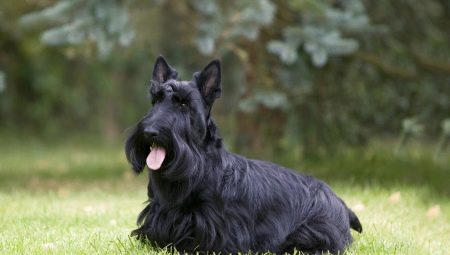Scotch terrier is an aristocratic breed of dogs that always attracts attention. Before buying such a pet, you need to familiarize yourself with the description of the breed, according to which it will turn out to choose a purebred puppy, and study the nuances of its content. A competent upbringing will help to get an obedient dog that will not cause a lot of trouble.
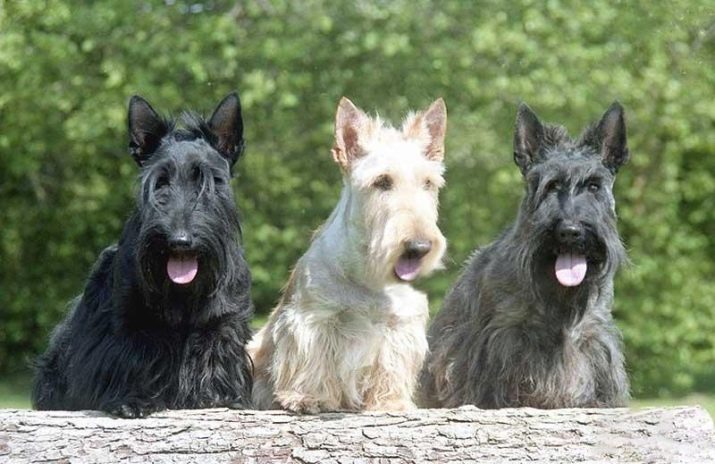
Origin history
The Scotch Terrier is the oldest Scottish breed of dog. However, although it has existed for quite some time, it was only in the mid-80s that it could get its portion of popularity. At that time, a breakthrough occurred in the history of the breed: people refused to cross the short-legged Scottish Terrier with a long-haired Englishman. But the real classification did not work out, so for several decades, all dogs that were used to catch rats or as burrows were called Scottish terriers. And in those days, such directions were inherent in the West Highland Terrier, sky, white and core terrier.
The process of becoming Scotch was hindered by promiscuous breeding. According to people, in every village in those days there was a vision of an ideal adhesive tape, which could be an incredible mixture of genes, combining many different breeds. In 1879, the breed began to take shape in a separate category. This was facilitated by the decision of the English Kennel Club, according to which, Scottish Terriers should be placed in different categories, depending on the coat color.
History knows the name of the first breeder, Captain Mackey, who played a key role in the process of dividing adhesive tapes into groups.
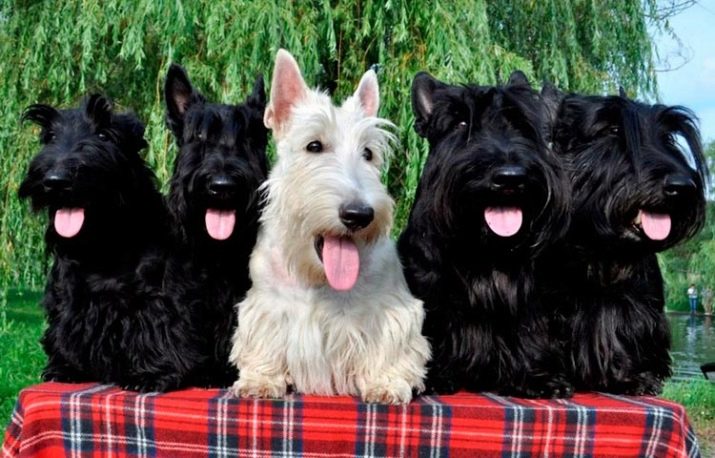
In 1880, Mackey traveled to Scotland and bought from the peasants dogs with wheat and black wool. Due to his activities, in 1883 the breed had a breed standard that separated it from the white West Highland and the ashen sky terrier. In the United States, the scotch terrier appeared in the XIX century, but this breed did not impress anyone. Interest in animals arose after Franklin Roosevelt acquired them.
Dogs were brought to Russia in the first half of the 20th century, and they lived with the Rurikovich. However, after the revolution, the breed was again forgotten, and remembered only in 1930. At that moment, it didn’t come to breeding, as the Great Patriotic War began. Pedigree breeding in Russia started in the mid-70s, when representatives of the breed began to be imported from abroad.

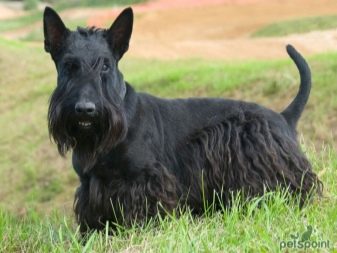
Description
Externally, dogs are squat and shaggy animals with a slightly disheveled beard and short limbs. The dog does an excellent job of digging even hard soil. Since animals belong to the category of small terriers, they are unable to demonstrate large sizes, but are not considered miniature. The characteristic of the breed provides for a height at the withers of 25 to 28 cm, and the weight of the dog can be up to 10.5 kg. The standard approves identical indicators for females and males.
- Head. The skull of the dog has an elongated shape. It should not be too flat, a small depression from the forehead to the muzzle is located at eye level. The head itself is not too wide, has a square shape. The segment between the outer ears and the outer corner of the eye is of a decent size. Cheeks are straight and flat. Cheekbones do not protrude too much.
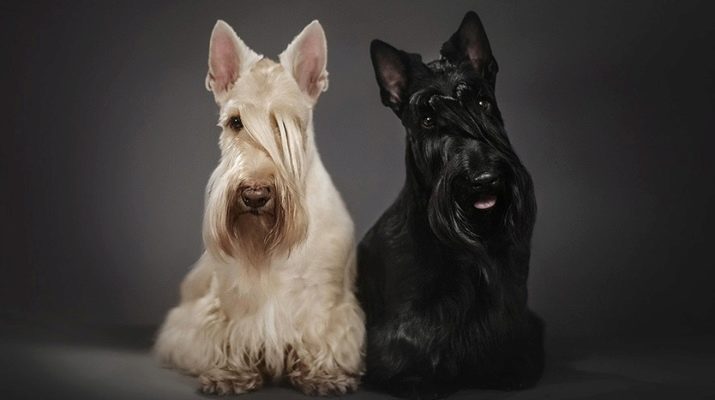
- Jaw. Scissor bite. The jaws have large teeth.
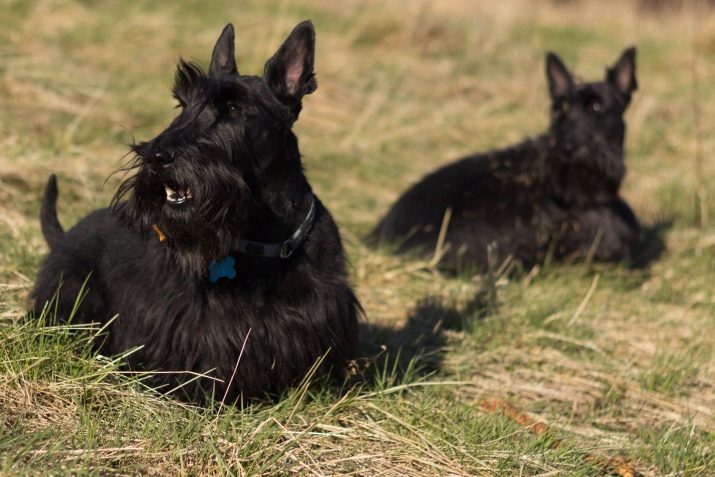
- Nose. The nose is massive, black. The line that goes from the earlob to the chin should be slightly beveled.
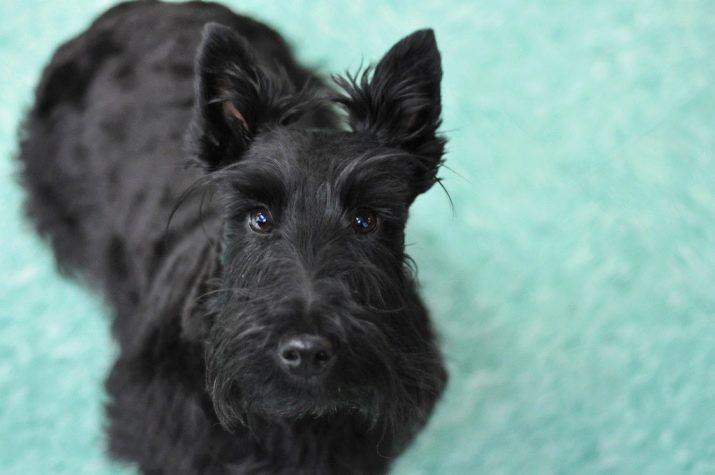
- Eyes. The eyes are dark brown, slightly covered with drooping eyebrows, landing wide. The shape of the eyes is almond-shaped. The look of the scotch terrier is distinguished by arrogance and insight.
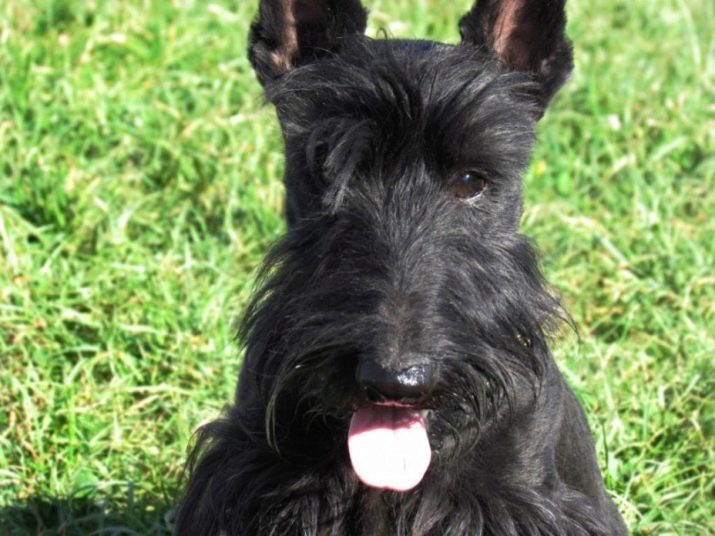
- The ears. This breed is characterized by thin erect ears, the shape of the ears is pointed.

- Neck. The neck is not very long, but rather muscular.
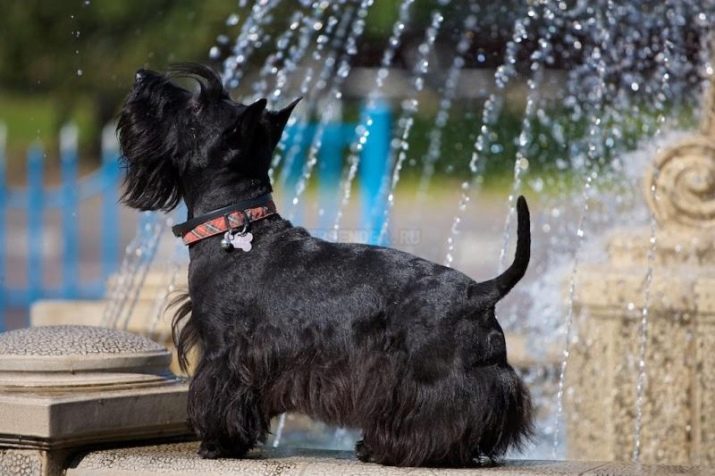
- Torso. The back of the dog is short, should be flat. The top line is almost horizontal. The chest is wide, protrudes forward and slightly falls down.
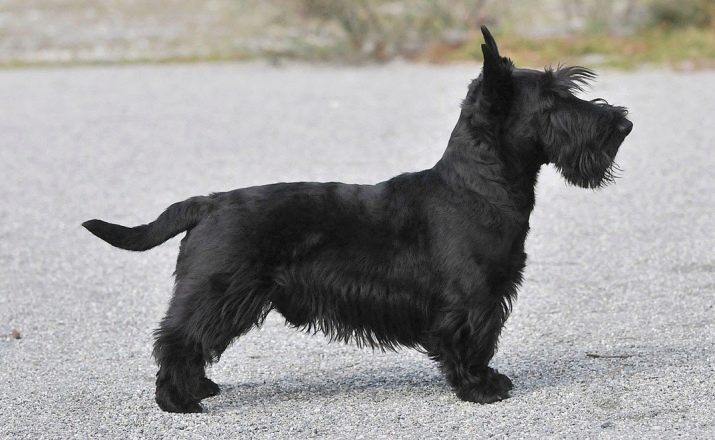
- Limbs. The forelimbs are short, set in parallel. Forearm bony, metacarpus straight. The hind limbs have large hips, the hock is strong, despite the fact that its length is short. The paw is in a lump, the pads are large.
Although the scotch terrier has short legs, he is able to cope with a march-throw of 10 km or an hour-long excavation. For this breed, such loads are not difficult.
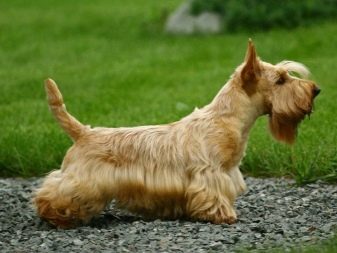
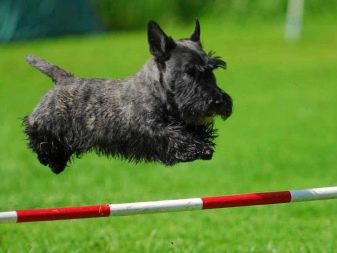
- Tail. The tail length is 16-18 cm. The base is thickened, the production is almost vertical. By standard, a slight tilt is allowed.
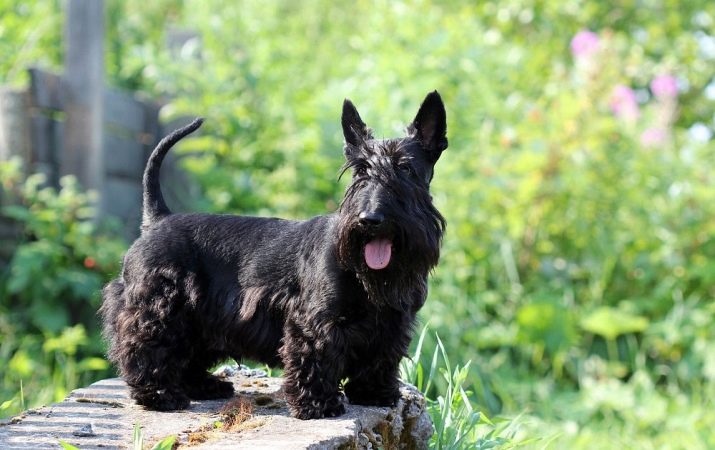
- Coat. The coat is formed due to a tight-fitting undercoat, a pair of which is a wire-like integumentary hair. The length and density of the coat reaches a maximum mark in the lower half of the animal's body. With the help of such a cover, the dog receives a “skirt” with “pants”.
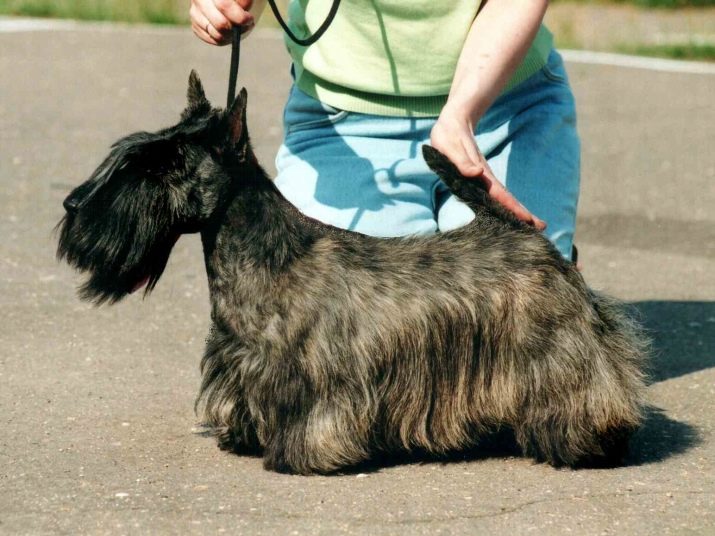
- Permissible colors. In the breed standard, black, tiger and wheat colors are allowed. The last two species can exist in any variation. Tiger color is able to combine with any shades. Wheat color can be light golden, red is also a plus. White color is currently not popular. If the puppy has this color, it is not subject to disqualification, but is not allowed to the exhibitions.
It is possible to exhibit animals with white spots on the chest, the size of which does not exceed a 25-penny coin.
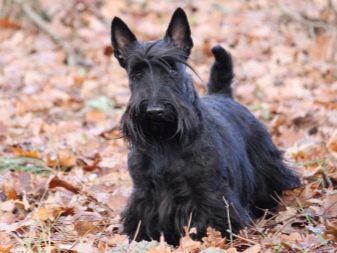
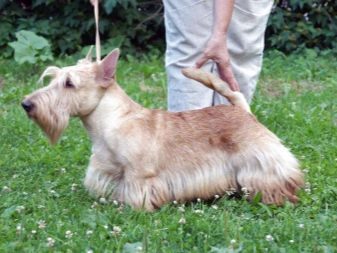
- Defects of the breed. Dogs are subject to disqualification if deviations from the specified standard are observed or there are defects in behavior. These features include cowardice, excessive aggression.
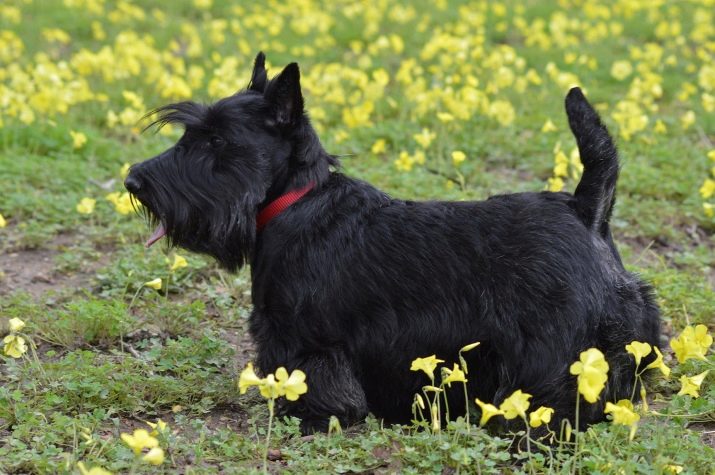
Character
Many people fall in love with the charming look of the Scottish Terrier as soon as they see it. But, This breed is characterized by a variable character, which does not combine with a charming appearance. More recently, a funny dog who enjoyed playing with its owner can transform into an animal that exudes irritation and anger.
Pathological obstinacy is another feature of this breed., and it can complicate the relationship between the pet and its owner. To achieve complaisance from the dog, the owner must show the puppy who is the leader in the house from the first day. The scotch terrier is a small dog that has great courage, along with self-esteem. Often you can encounter willfulness, which manifests itself in the fact that the pet specifically does what he wants. Nonetheless, the animal is anxious about the territory entrusted to it and will never let strangers into it.
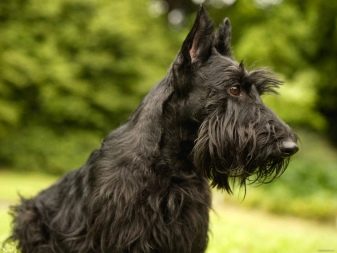
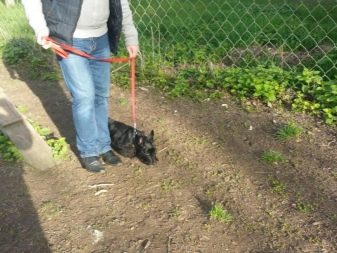
Some individuals can boast of a pronounced manners of the leader and will aggressively respond to their relatives. In order for the pet to communicate well with other animals that exist with it under one roof, it is necessary to start the question of socialization from puppyhood. Otherwise, you may encounter the fact that the instincts of the hunter will triumph, and the dog will constantly hunt for everyone. Walking your pet, you need to consider hunting qualities due to which the adhesive tape can rush after another animal.
Scottish Terrier is a sensitive dog. She is only able to determine the mood of her owner by the intonation of her voice. If the animal does not consider its owner a leader, it will permanently infuriate it. Another characteristic of these dogs is their devotion and vigilance. For this reason, scotch tape is considered a good watchman. In addition, the dog prefers only one person or two, with whom he will closely communicate. The dog behaves with strangers wary and detached. He will not caress with them.
Scotch is characterized by increased playfulness. The dog will play with the ball with great pleasure, arrange races on home territory or on the street.


Advantages and disadvantages
The scotch terrier is a special dog that differs from its brethren not only in appearance but also in character. Before choosing a fourth friend, you should familiarize yourself with the positive and negative traits of the animal to make sure that it is correctly acquired.
Consider the most obvious benefits of Scots.
- Miniature sizes and decorative features. Due to its small size, the animal can live in an apartment, it does not need a lot of space.
- Unpretentiousness in leaving. Such a dog does not need complicated care. He only needs a haircut, since the wool does not shed on its own.
- Resistance to various diseases. Scotch terrier is rarely sick and can boast of good health.
- Independence. The dog can be left alone: it is famous for its natural self-sufficiency, so it will not be homesick during the absence of the owner.
- Lively mind and quick wits. These dogs quickly understand what’s what, and on the fly they learn new skills.
- Devotion. Breeders say that if you find an approach to your pet, he will become a true friend until the last day.
- Sociability. The animal loves human society and is always ready to be near, while it will not be very intrusive.
- Love for walks. The dog is not against long walks, and they are vital to him.
- Activity and energy.
- Pleasant appearance. Scotch terrier always attracts the attention of people on the street.

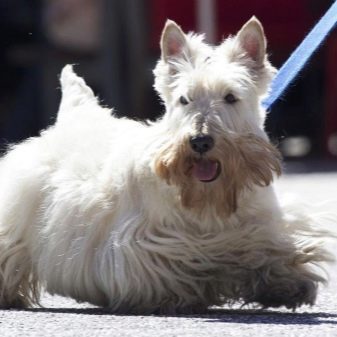
However, the breed has some negative features.
- Pride and obstinacy. The dog can go on the principle and insist on his own. In order for the animal to be obedient, you should engage in the process of education from the first day, and always insist on your own.
- The terrier does not get along well with other pets. The dog will be constantly jealous of its owner.
- The hair should be monitored by trimming.
- The dog will bark frequently and piercingly.
- The breed is suitable only for an experienced owner.
- Walking twice a day is required, along with physical activity and jogging.
- The animal is not suitable for those who lead a sedentary lifestyle.

Life span
If you provide these dogs with proper care, they live quite a long time - 13-14 years. The scotch terrier is a genetically healthy dog that is distinguished by endurance. They have activity in the blood, and they retain it until their venerable age. However, the breed has some serious diseases that can be hereditary.
- Scotty cramp (cramps). This is a neuromuscular disease that occurs if the animal is in an excited state. At this moment, he may experience cramps, loss of consciousness is not observed. Such a disease is not progressive, so the dog will live normally with her. The number of seizures is individual.
- VWD and hemophilia. Hematopoietic system disease. It manifests itself in the form of bleeding associated with a blood clotting disorder. If the disease is severe, bleeding can be spontaneous and begin in the internal organs, muscle tissue or joints. Due to an incurable disease, many scotch tapes died at a young or even puppy age.
- Cushing's Syndrome. This is a disease of the endocrine system. Manifested in excessively produced cortisol. You should contact your veterinarian if the scotch terrier is losing weight, experiencing increased thirst, he has frequent urination, darkening of the skin, and hair loss. The treatment is expensive and lengthy. If therapy is neglected, the dog may die.
- Scottish Terrier may also suffer skeletal diseases, dysplasia, pulmonary stenosis, retinal atrophy.
Most diseases can be detected using a genetic test, so you can learn about them before buying a puppy.

How to choose a puppy?
A puppy who is 8 weeks old is quite difficult to verify for compliance with the standard. Scotch terriers acquire breeds only in 5-6 months. Therefore, in order not to encounter the purchase of a non-purebred or non-standard pet, it is recommended to contact only trusted nurseries. Each binding must be planned and registered with the club.
Owners who are afraid to buy a “defective” dog can find a dog breeder who sells grown puppies. Among the six-month-olds it will be possible to see how promising the dog is for an exhibition career. However, the cost of such a dog will be much higher compared to two-month-old puppies.
When choosing, you need to know that the head of the little Scottish terrier will look too massive in relation to the general appearance of the animal. This is a normal situation. But if an eight-week-old dog looks completely formed, and resembles an adult in its features, this suggests that in the future the pet will have a lightweight skeleton with a short skull.
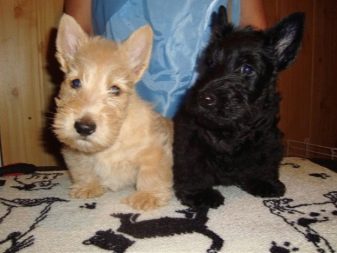

The puppy should be checked for health. To do this, examine his ears, the area under the tail. Both areas should be clean. Redness is not allowed in the inguinal region and under the armpits.
It is important to assess the temperament of the future pet while he is with his brothers and sisters.A shy and slow dog is not a good option.
If the puppy is too shaggy, and his skull is abundantly covered with wool, you should refuse to buy. In the future, such an adhesive tape terrier will be soft-coated, which is considered a serious flaw. It is recommended to choose puppies with a smooth coat.
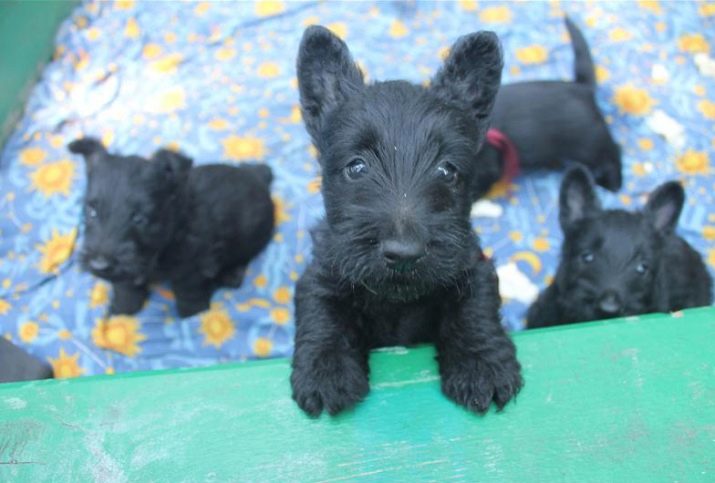
Maintenance and care
The Scottish Terrier can be kept in a small apartment, if you provide it with long walks and physical activity. The dog must run. When the baby was brought into the house, it must be placed next to the owner, since the pet needs close communication with the person. Also, this arrangement will allow the puppy to quickly understand who is his mentor and friend. The place to sleep should be equipped with wooden sides up to 10 cm high. When installing, make sure that the bed is raised a few centimeters above the floor surface. Such a maneuver will help save the pet from drafts.
Toys are a prerequisite for keeping a dog. With their help, you can distract the attention of the pet from furniture and other items in those moments when the dog is left alone. Some owners replace the usual toys with an apple or a cabbage stalk.
The surface of the floor should be covered with rugs or newspapers. The puppy's legs will be scattered on the bare floor and this can lead to improper positioning of the limbs or to injuries. Walk the pet only on a leash until the skeleton of the dog is formed. Then you can use the harness. The muzzle is an indispensable accessory, you should teach your pet to it since childhood.
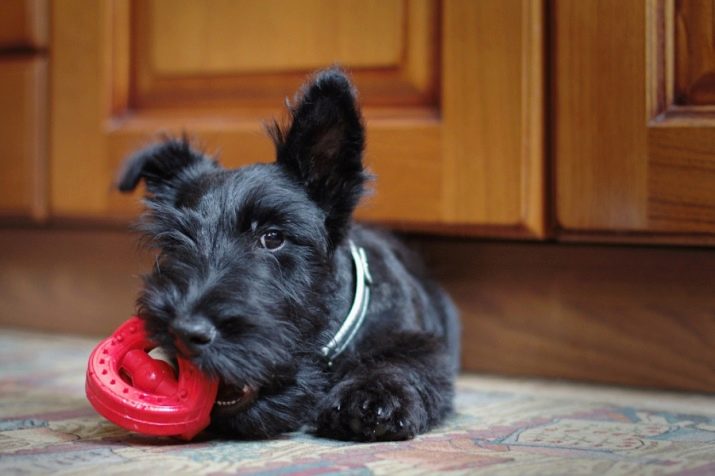
Scotch terrier is not suitable for the person who spends most of his life on the couch. In the first six months of his life, he will need walks every two hours. Next year, the dog is walked 4 times a day. When the pet is 1.5 years old, you can accustom him to two-time walks. The duration of one walk should be at least two hours. If you do not want to walk your four-legged friend for so long, you can resort to a three-time walk, where walks will last one hour.
Periodically, the dog needs to be bathed, in the summer this should happen more often than in the winter. In autumn, special clothing should be worn so that the terrier does not get dirty. Bathing should be done in warm water, using specialized shampoos designed for coarse wool.
“Doggy” scotch terrier almost never smells. Therefore, with this symptom, you should pay attention to the animal’s nutrition: the diet should be balanced, without allergens.
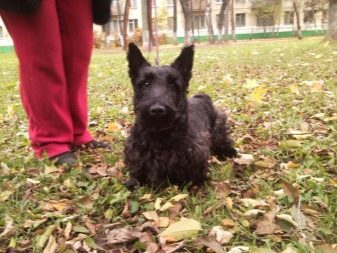

Ear care only occasionally. The breed is characterized by small open ears, so otitis media is not terrible for her. The teeth of the scotch terrier are strong and healthy. Their condition is at "excellent" to a very old age. Claws need to be trimmed regularly, even if the pet is constantly getting a load. Special attention should be paid to the beard of the terrier. It needs to be wiped after each intake of water and food.
It’s better to immediately buy flat bowls with an automatic watering machine designed specifically for bearded breeds. Eyebrows, eyelashes and eyes are areas that you should also pay attention to. Since the hair is hard, it can irritate the mucous membrane of the eye, which will lead to diseases.
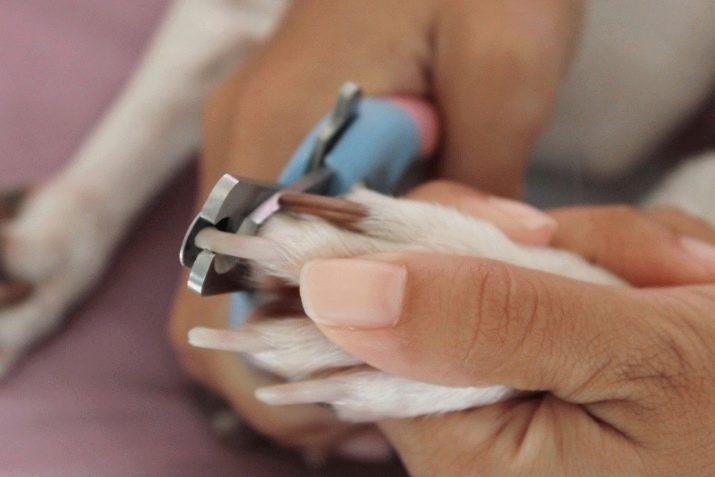
The subtleties of haircuts
The coat of the scotch terrier requiresso that he is provided with constant trimming and haircut. These are the only conditions that must be observed when keeping dogs. They do not need constant combing, therefore, to trim your pet, you will need to find a good master (for exhibitions this is a prerequisite) or to master the skill yourself.
The Scottish Terrier has a hard coat, which protects the dog well from exposure to heat and cold, but without mechanical impact it does not fade.Therefore, old hairs that have lost their elasticity and shine should be plucked by hand. Trimming should be done 2-4 times a year.
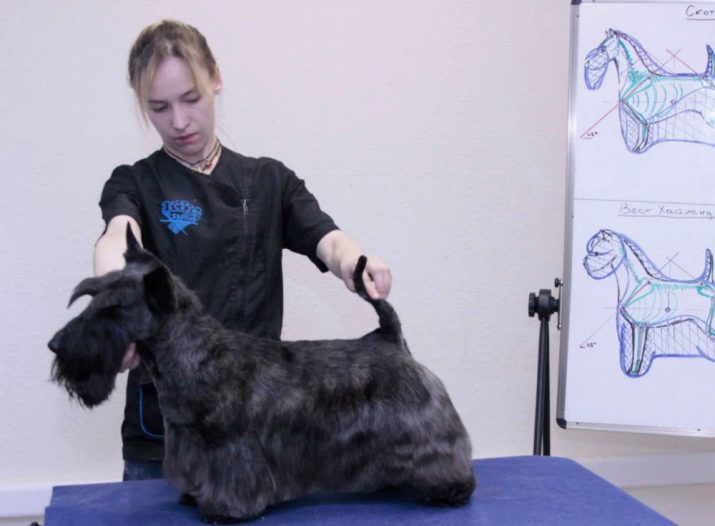
The home haircut scheme has the following nuances.
- The coat, which is located on the head, cheeks, neck and throat, must be shortened using a machine or scissors. Be sure to leave the dog her eyebrows with a beard, thanks to which the animal has a concentrated look. It is necessary to check that the length of the hair does not interfere with the dog's vision.
- Short hairs should be removed along the back of the nose, thus obtaining a parting. Ears are trimmed according to a similar principle, with the conservation of pointed tips.
- To give a neat appearance, the fur on the sides, back and under the tail is also shortened. On the shoulders, the hairs are removed from the sides.
- The skirt should be located on the stomach, hull and legs. The length can be different: from a few centimeters to the length of the floor.
This is the home option for cutting a scotch terrier. A lot of details are provided for the exhibition, which include requirements for the thickness and length of the coat. Therefore, such dogs will need grooming, which will be carried out by a professional.

What to feed?
There are two categories of owners: connoisseurs of prepared food and fans of natural nutrition. If the owner plans to use ready-made dry food, you need to choose only from a high-quality and balanced line. Premium, super premium will do. The composition should be low in protein.
Since the Scottish Terrier has a good appetite, the owner of the dog should monitor the amount of food consumed by his pet. You cannot feed a dog from the table.

If the owner wants to feed the dog with natural food, remember the following rules.
- Do not give a dog fatty and junk food. The liver is the weakness of scotch tape, so it’s better not to risk it.
- Raw food is a priority, since during heat treatment protein is released.
- It is forbidden to give dyes, flavor enhancers and preservatives.
- Meat - this is the basis of the diet. You should feed your pet beef with cartilage or chicken. The meat is cut into small pieces and served raw. Forcemeat to feed a four-legged friend is undesirable.
- You can give the dog vegetables and cereals. Of cereals, buckwheat, rice, and oatmeal are allowed. You can add vegetable oil with finely chopped herbs.
- Sour milk products can be given. You can’t feed with milk.
- Boiled eggs, dried fruits, raw sea fish (fillet) - also a valid list of diet.
- You can systematically feed large bones in which there are no sharp edges. You can also buy special bones sold at the pet store.

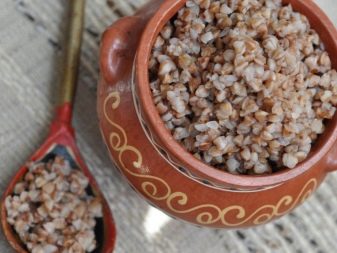
Parenting
The scotch terrier is a smart but stubborn dog that does not tolerate criticism. She is very sensitive in terms of praise and flattery. These features of the character should be known to every owner of an adhesive tape terrier who decided to start the educational process.
At the very beginning of the training, the Scottish terrier is able to learn with pleasure, but as soon as the classes become familiar to him, without news, he will immediately lose interest in them. Selectivity is another character trait that dog handlers dislike. The scotch terrier is able to perfectly execute the commands that he likes, but ignore those that are not interesting to him. You can develop interest with the help of sweets and affection. Other options do not apply.
To date, a special training program for this breed has not been developed. However, dog breeders believe that the classic technique for scotch tape is not suitable. You can try to combine games with learning, shortening the lesson as much as possible.
Adhesive tape is not a dog that will work through fatigue and boredom. For this reason, group classes are not suitable for such animals, since they last a long time, and this quickly frustrates the Scotch terrier.
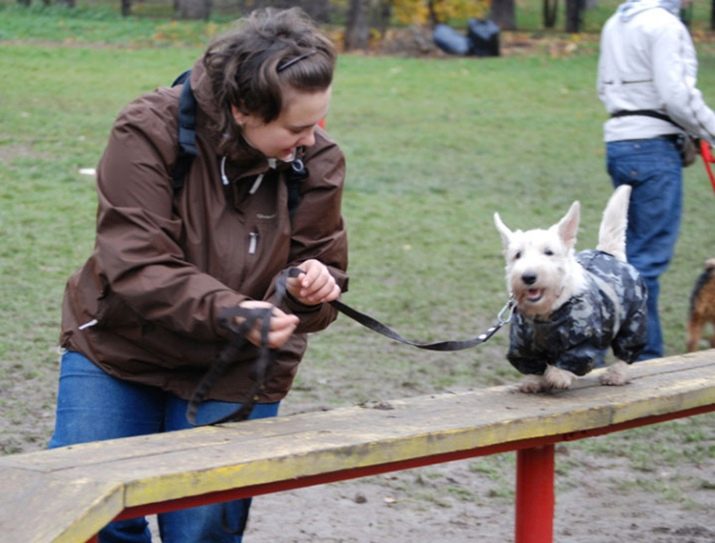
To cope with the instinct of the hunter, because of which the dog will have to constantly run during walks, you need to immediately accustom him to a leash. A well-bred dog will cause less trouble to its owner. Every owner should also know that the scotch terrier is an incredibly active dog, and nothing can be done about it.
You can only distract the pet’s attention with toys from other objects, but expensive shoes should be hidden. Expensive repairs do not need to be done until the dog has become an adult. If the puppy becomes too impudent, it can be punished with light slaps. It is allowed to apply such punishment only at the time of misconduct, so that the terrier understands why he is being punished.
Puppies like to bite, which should immediately be stopped, because in adulthood the animal will continue to show aggression. Shouting at the dog will not work. This technique can work with other breeds, but with a Scotsman such training can only lead to frustration or resentment. You should not expect that the pet will immediately begin to understand the command, for a start he must decide on the purpose of its implementation. No need to load the dog with constant repeats of acquired skills. It will only tire him.
Training should be from the first day of a puppy’s life in a new house. This is a prerequisite for obtaining an obedient pet, because this breed was bred for independent work, where dependence on a person is not required. Due to this, the scotch terrier may be particularly stubborn in training. If the owner of the dog does not have enough time and energy to work with the terrier, you can contact a specialized school for help.
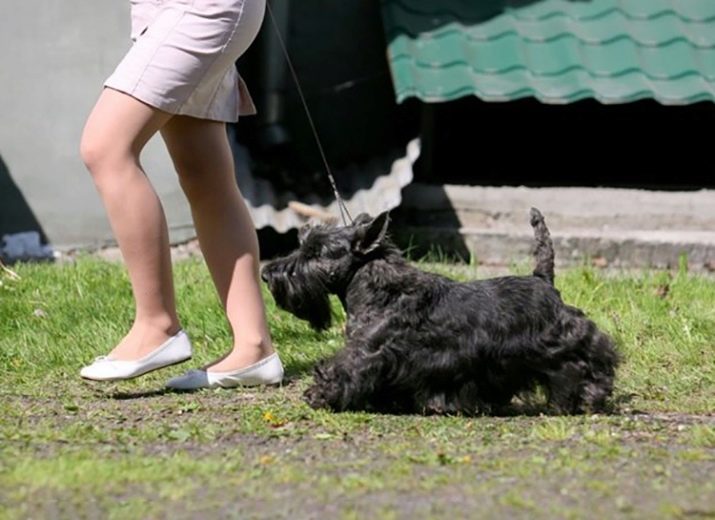
Now the scotch terrier is rarely used as a hunter. This is due not to a decrease in hunting instincts, but to the unwillingness of the owners to train their pet in this area. Dog breeders are more interested in the external data of the terriers, therefore they do not allow the dog to swarm in the ground.
If the owner wants to remind his dog about the skills of the pursuer, it is enough to visit the privet zones of his region, where the scotch terrier will quickly recall its origin. After a couple of months of training, he will be a highly skilled fox catcher, and will be able to conquer even the deepest holes.
At such trainings, the dog will be freed from excess energy. He will do what he loves, getting the physical activity he needs. However, the owner of the dog should be extremely careful during the walk: if the owners usually try to quench the instincts of the hunter, this will not work here. In ordinary life, the dog will also pursue its goals in the form of cats and small dogs.
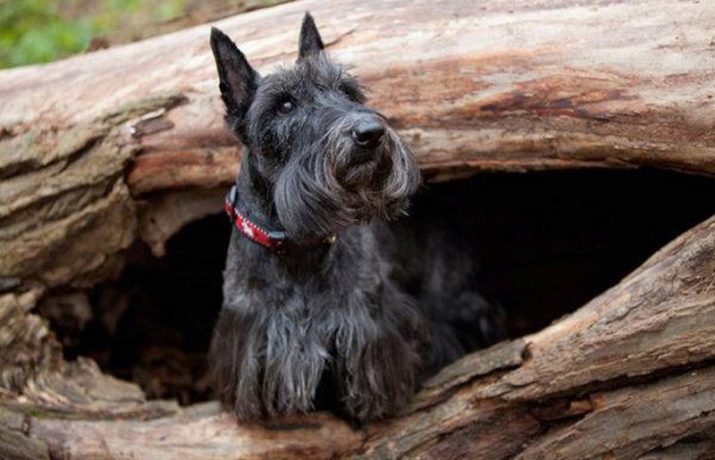
Owner reviews
Reviews of scotch terriers can be controversial, but negative comments are often related to the fact that the owner does not know how to handle the dog. By studying the reviews of the owners, you can learn more about the features of the breed and decide whether it is suitable for a particular person or whether you should pay attention to other four-legged pets.
Many people talk about the exceptional devotion of their pet, which is always ready to be near, but at the same time it will not become intrusive. He may simply be near a person while he is busy with business. Many owners say that the Scottish Terrier feels good next to the elderly. The dog appreciates peace and quiet, and will be a faithful companion for them.
Tough, hypoallergenic wool is another reason for owners to delight. Adhesive tape does not require special care, it does not need to be combed out, it has healthy teeth from birth.
The only condition for leaving is systematic haircuts, which will require the allocation of additional funds. However, many owners of non-show individuals learned to cut their dogs with their own hands.
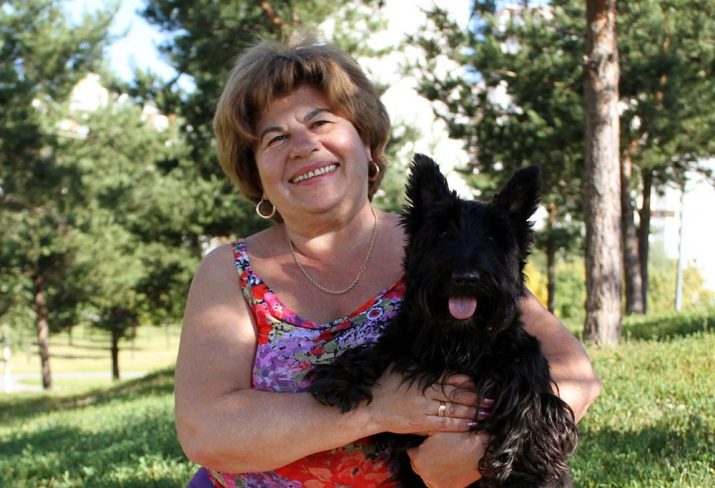
Stubbornness and independence are characteristic features of an adhesive tape terrier. He does not like coercion, and if the owner forces the dog to execute commands through force, she will fundamentally refuse to obey. This issue is being addressed through early education. You can find an approach to any pet and gain its respect by showing yourself as the leader of the pack.
The dog does not like finding other animals in the house. The scotch terrier is very jealous and can be aggressive. It is necessary to suppress all manifestations of negativity even in puppyhood, so that there are no problems in the future. Increased barking is another shortcoming of the breed that some people complain about. The dog may bark too often, but it still does not compare with the amount of noise that other small dog breeds make. Besides, the barking problem can also be solved by proper education.
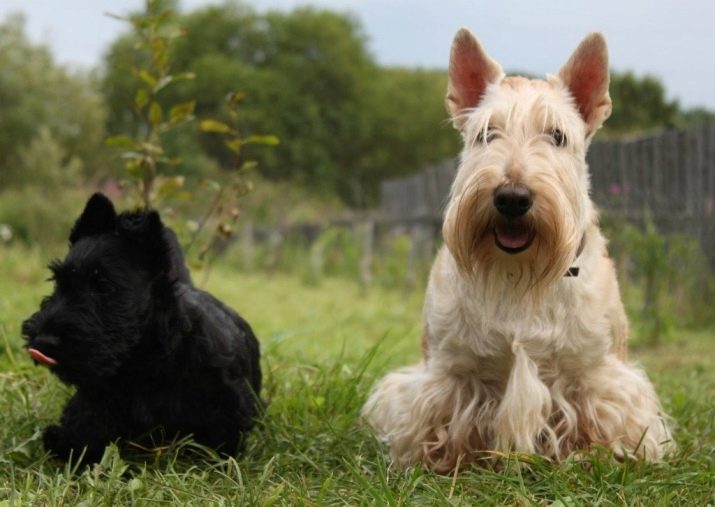
See more about breed features in the next video.
